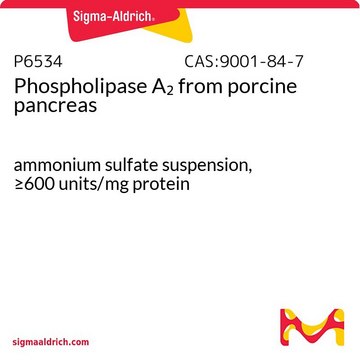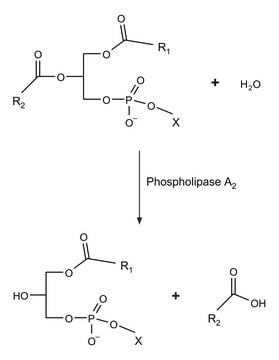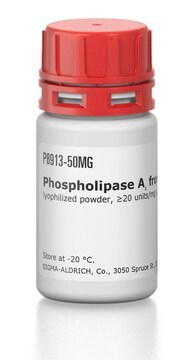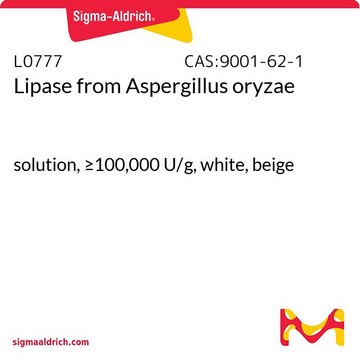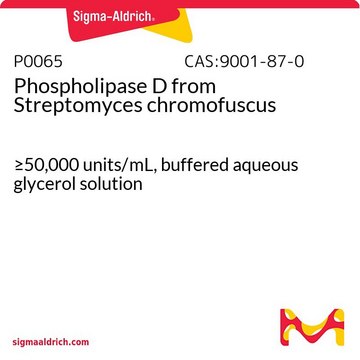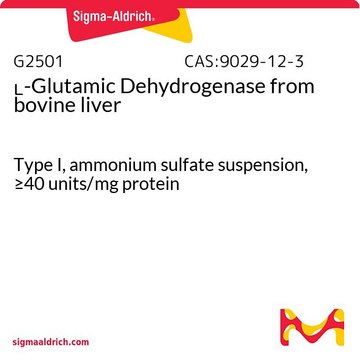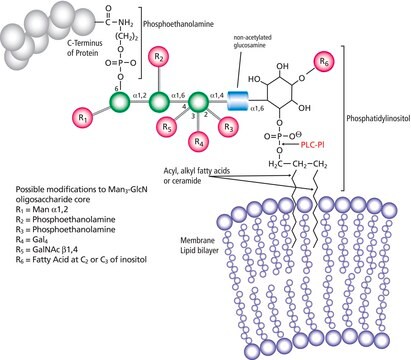L3295
Phospholipase A1 from Aspergillus oryzae
Sinonimo/i:
Lecitase™ Ultra, PLA1
Autenticatiper visualizzare i prezzi riservati alla tua organizzazione & contrattuali
About This Item
Numero MDL:
Codice UNSPSC:
12352204
NACRES:
NA.54
Prodotti consigliati
Ricombinante
expressed in Aspergillus oryzae
Stato
liquid
Attività specifica
≥10 KLU/g
Temperatura di conservazione
2-8°C
Descrizione generale
Phospholipase A1 (PLA1) catalyzes the hydrolysis of acyl group from position 1 of lecithin to yield lysolecithin. It is expressed in a wide range of organisms such as rat platelets, bovine brain and testis, hornet venom, bonito muscle and fungi. Gene coding for PLA1 consists of four exons and three short introns spanning 1,056bp of genomic DNA. Mature protein contains 269 aminoacids and two possible N-glycosylation sites (Asn27 and Asn55).
Applicazioni
Phospholipase A1 from Aspergillus oryzae has been used:
- in the preparation of sn-1 and sn-2 C18:1- lysophosphatidylcholine (LPC) regioisomer standards
- as a catalyst for the synthesis 6-O-glucosyl-poly(3-hydroxyalkanoates) in a micro-aqueous system
- to catalyze the synthesis of methyl butanoate and methyl benzoate flavor esters in continuous flow microreactor
- to hydrolyze 17:0 phosphocholine (PC)
Risultati analitici
minimum activity 10 KLU/G liquid
Note legali
Lecitase is a trademark of Novozymes Corp.
Avvertenze
Danger
Indicazioni di pericolo
Consigli di prudenza
Classi di pericolo
Resp. Sens. 1
Codice della classe di stoccaggio
10 - Combustible liquids
Classe di pericolosità dell'acqua (WGK)
WGK 1
Punto d’infiammabilità (°F)
Not applicable
Punto d’infiammabilità (°C)
Not applicable
Scegli una delle versioni più recenti:
Possiedi già questo prodotto?
I documenti relativi ai prodotti acquistati recentemente sono disponibili nell’Archivio dei documenti.
I clienti hanno visto anche
Thermomyces lanuginosus lipase-catalyzed synthesis of natural flavor esters in a continuous flow microreactor
Gumel AM and Annuar MSM
3 Biotech, 6(1), 24-24 (2016)
Naoaki Arima et al.
Journal of lipid research, 53(3), 513-521 (2011-12-17)
Members of the pancreatic lipase family exhibit both lipase activity toward triacylglycerol and/or phospholipase A(1) (PLA(1)) activity toward certain phospholipids. Some members of the pancreatic lipase family exhibit lysophospholipase activity in addition to their lipase and PLA(1) activities. Two such
Yukichi Fujikawa et al.
Lipids, 47(3), 303-312 (2011-11-30)
A cDNA encoding protein with homology to plant secretory phospholipase A₂ (sPLA₂), denoted as Nt1 PLA₂, was isolated from tobacco (Nicotiana tabacum). The cDNA encodes a mature protein of 118 amino acid residues with a putative signal peptide of 29
Nicole A Housley et al.
Journal of bacteriology, 193(18), 4634-4642 (2011-07-19)
Here we have characterized the Rickettsia prowazekii RP534 protein, a homologue of the Pseudomonas aeruginosa ExoU phospholipase A (PLA) secreted cytotoxin. Our studies showed that purified recombinant RP534 PLA possessed the predicted PLA(2) and lyso-PLA(2) activities based on what has
Alyssa L Bolen et al.
Journal of lipid research, 52(5), 958-970 (2011-03-12)
Platelet activation initiates an upsurge in polyunsaturated (18:2 and 20:4) lysophosphatidic acid (LPA) production. The biochemical pathway(s) responsible for LPA production during blood clotting are not yet fully understood. Here we describe the purification of a phospholipase A(1) (PLA(1)) from
Il team dei nostri ricercatori vanta grande esperienza in tutte le aree della ricerca quali Life Science, scienza dei materiali, sintesi chimica, cromatografia, discipline analitiche, ecc..
Contatta l'Assistenza Tecnica.